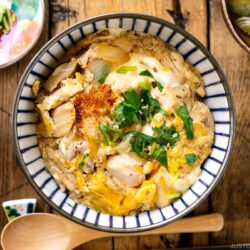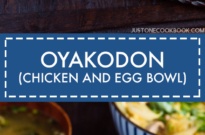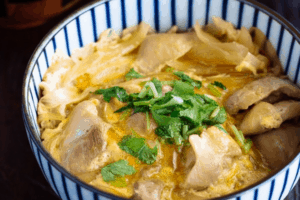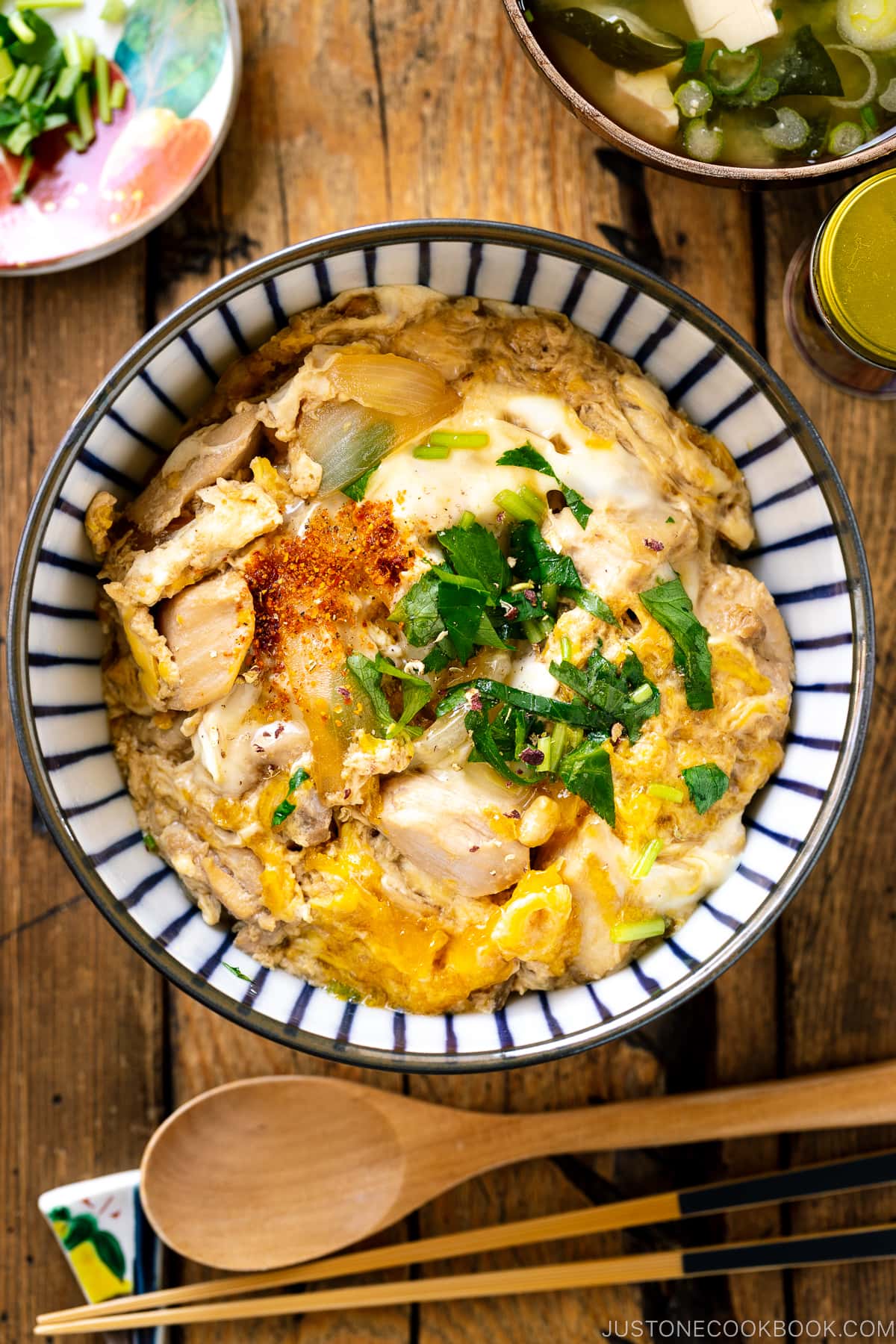
When it comes to mainstream fast food, Japan offers not only hamburgers and french fries, but the menu also extends to noodles and donburi (rice bowl) meals.
During lunchtime, you’d see diners and noodle shops around the office buildings crowded with Japanese office workers making their fuss-free fast food orders. These lunch spots usually serve up quick one-bowl meals, and Oyakodon (親子丼) or Oyako Donburi (親子丼ぶり) is often one of the popular choices.
Today, let’s make this quick and easy Chicken and Egg Rice Bowl at home!
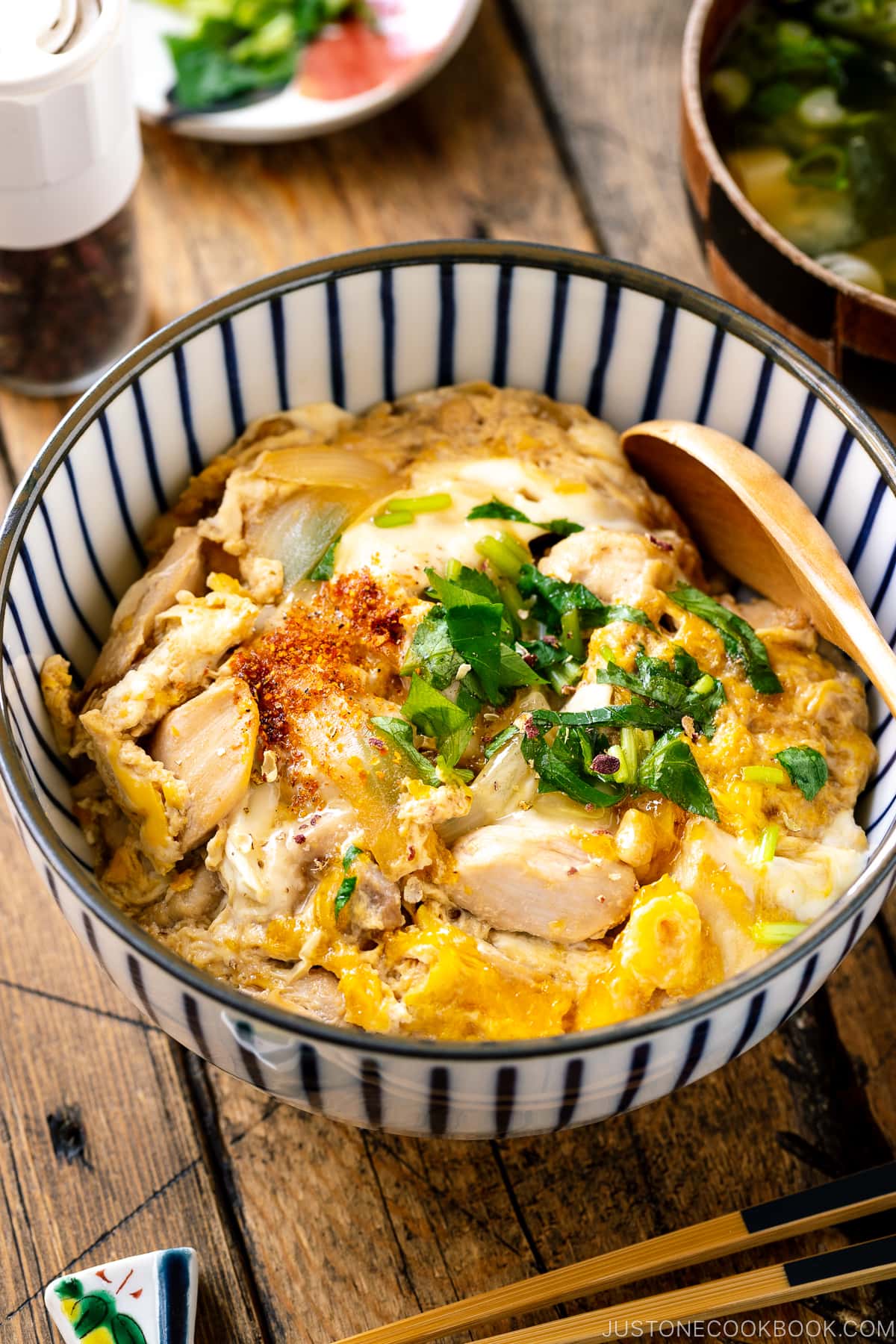
What is Oyakodon?
An epitome of Japanese soul food, oyakodon (親子丼) literally translates to parent-and-child (oya-ko) rice bowl (don) as the dish is composed of chicken and egg.
Bite-size chicken, tender onion, and softly cooked egg are layered and simmered together in a sweet-salty sauce made with dashi, soy sauce, and mirin and served on a bed of steamed rice. The contrast of textures and flavors makes you craving for more bites.
Like Gyudon and Katsudon, oyakodon is not only a long-time restaurant favorite but also a staple dish of Japanese households. Just as the name implies, everything about the rice bowl brings comfort and warmth.
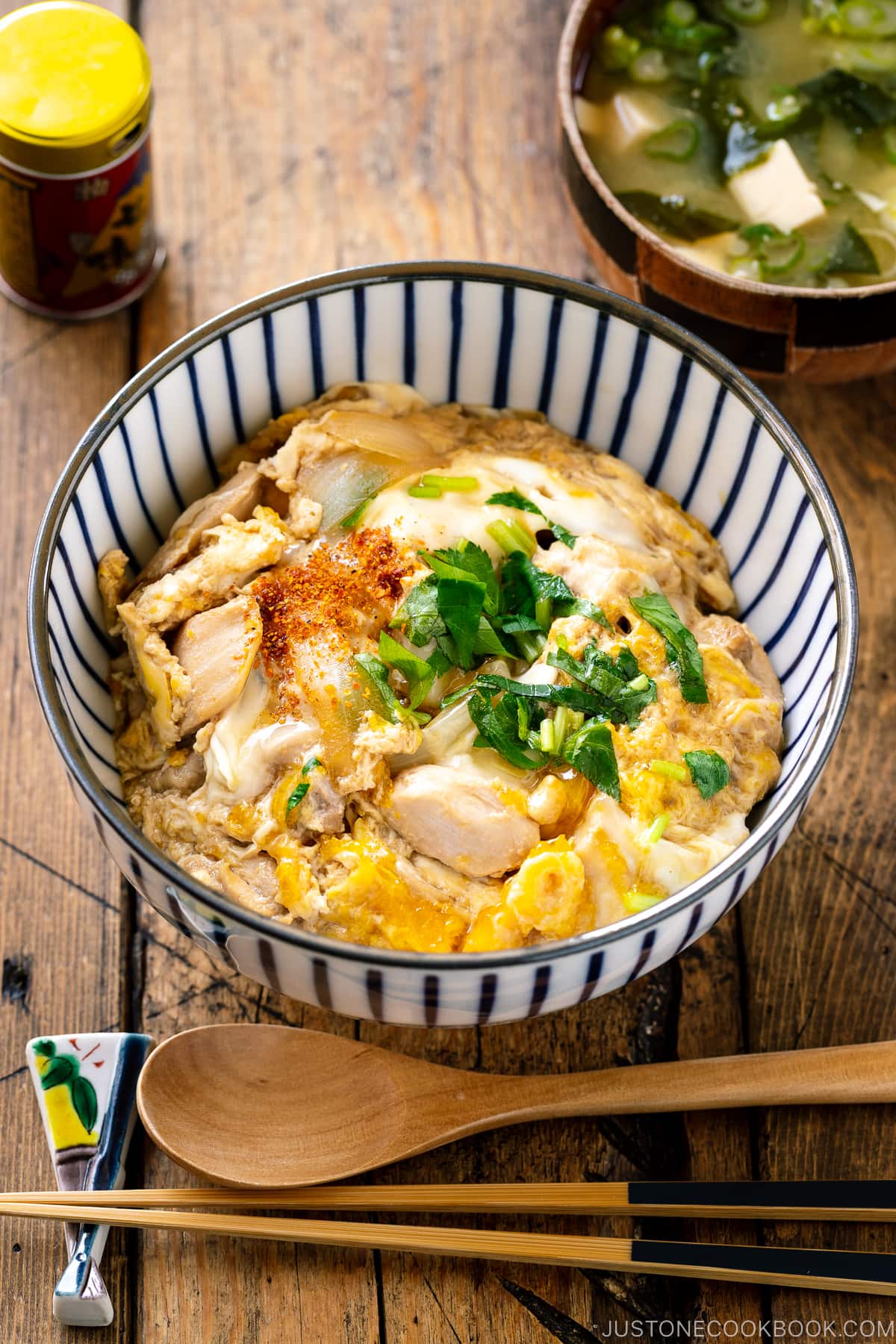
Why You’ll Love This Recipe
- One pan and one bowl meal. It is an ideal solution when thinking of easy weeknight meals. Fewer dishes = easy cleanup!
- Quick and easy 30-minute cooking! This dish can be whipped up with minimal time and effort. I first learned how to cook oyakodon in my home and economics class in middle school. These days, it is still one of my go-to comfort foods. If you have teenagers at home, oyakodon is a great dish they could easily master. It is a survival meal that will sustain them when they go to college.
- Easy-to-access, pantry-friendly ingredients. Chicken, egg, and onion are standard ingredients in most cuisines. I usually have them handy in my refrigerator (or freezer for chicken). As for the condiments, if you cook Japanese or Asian food often, you most likely have condiments and a dashi packet or powder.
- No oil! The onions and chicken are simmered in a broth. There’s no frying with oil.
- A satisfying comfort meal at home. Tender chicken and a soft-cooked egg are served over a bed of rice. The rice absorbs delicious dashi sauce, and every mouthful is sweet, salty, and savory. Here you have it: a belly-filling, delicious comfort meal in one bowl.
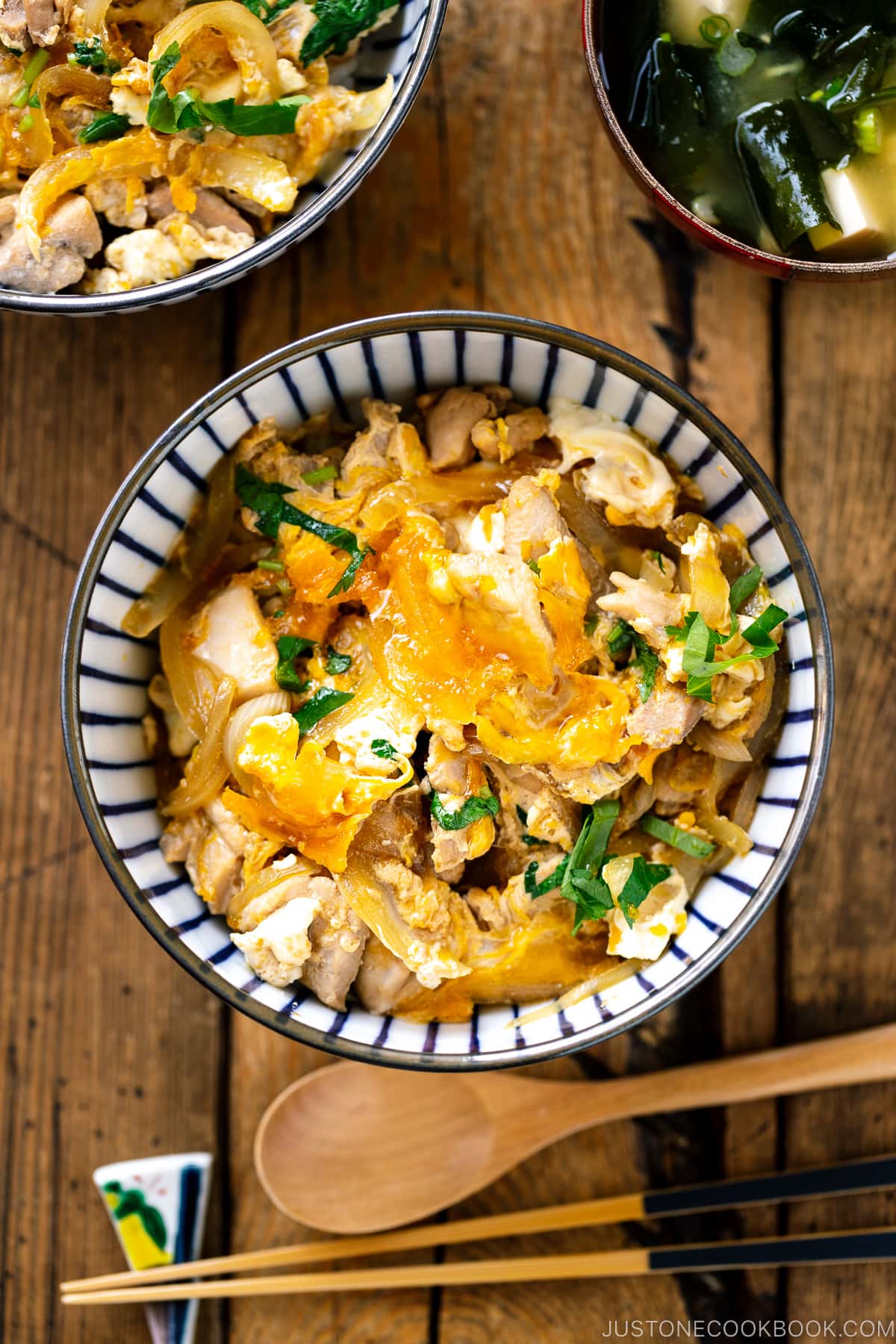
Ingredients for Oyakodon
- Chicken thighs — I recommend thighs over breasts because fattier thighs are more flavorful, tender, and forgiving (compared to dry, overcooked breasts).
- Sake — Drizzling a tablespoon of sake over chicken helps remove its gamey odor.
- Onion
- Eggs
- Seasonings — Dashi (Japanese soup stock), soy sauce, mirin, and sugar.
- Steamed Rice
- Garnish — Thinly sliced green onion or mitsuba (Used in many donburi dishes, this Japanese wild parsley has a celery-like flavor with a slightly bitter but refreshing taste.)
- Optional seasonings at the table — Shichimi togarashi (Japanese seven spice for a spicy kick) and sansho pepper powder (It is finely ground peppercorns from the prickly ash tree. It has a vibrant, peppery lemon flavor with a long residual heat).
How to Make the Best Oyakodon
- Prepare the ingredients: Cut the onion, mitsuba/green onions, and chicken and crack the eggs.
- Cook the onion in the seasoning mixture.
- Add the chicken and cook until no longer pink.
- Drizzle egg mixture at two separate times. Garnish mitsuba/green onions.
- Spoon the finished dish over the bed of steamed rice in a donburi bowl.
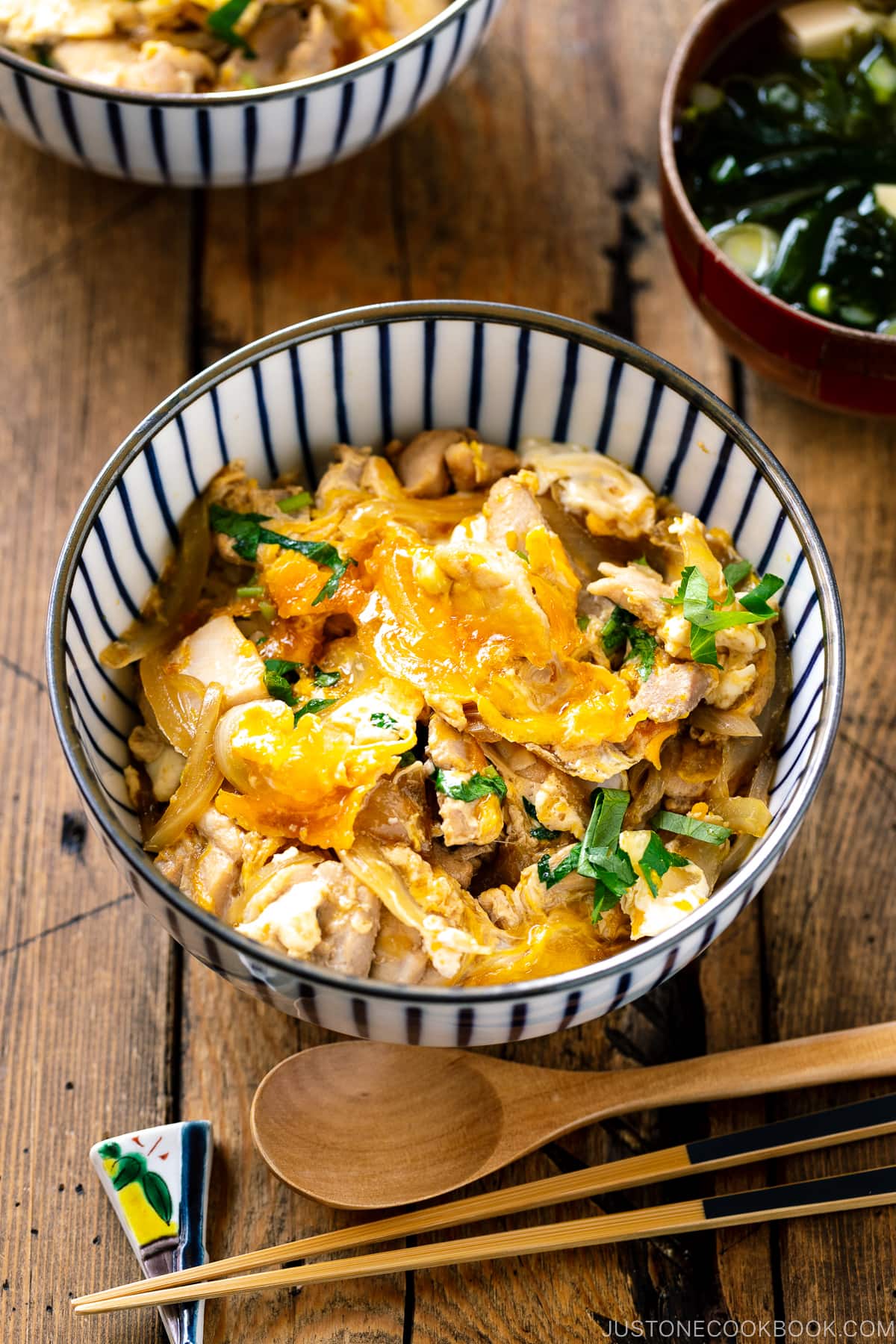
How to Make Dashi (Japanese Soup Stock)
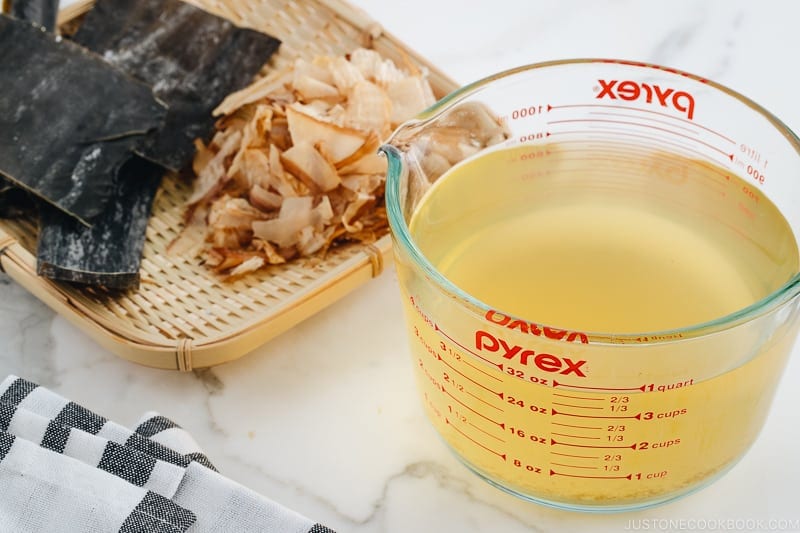
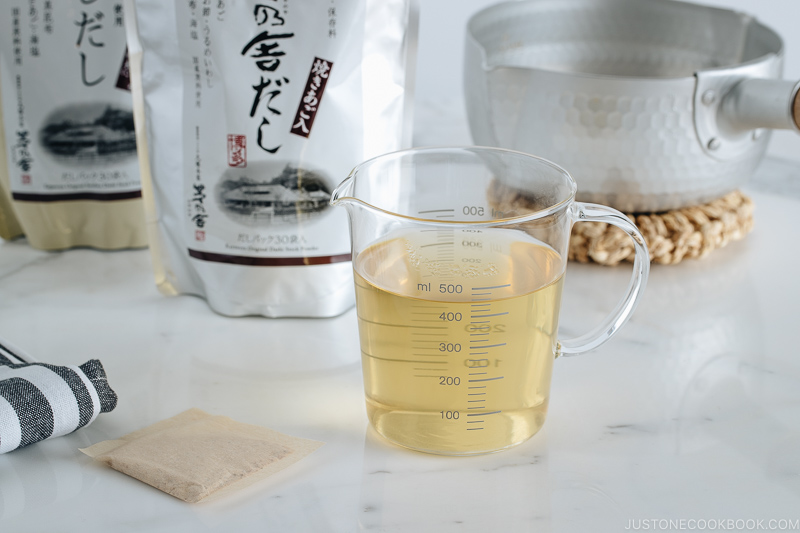
What makes this chicken and egg rice bowl authentically Japanese? It’s the flavor of dashi (Japanese soup stock). If you’re not familiar with dashi, think of this ingredient as the most essential flavor of Japanese cuisine. The good news is:
- It’s so easy to make compared to other stocks; homemade dashi takes 30 minutes.
- It can be vegan-friendly – read Vegan Dashi.
- Dashi can be made instantly with a dashi packet (my preferred method over dashi powder).
I highly recommend reading my Ultimate Dashi Guide as dashi appears in the majority of Japanese recipes and you can’t avoid it.
For two servings, I recommend making a pot of dashi (about 4 cups) and then using ½ cup for Oyakodon and the leftover (3½ cups) for Homemade Miso Soup to serve as a meal set. Now you have a filling rice bowl and a soothing miso soup.
Cooking Tips
Tip 1: Use the Japanese cutting technique “Sogigiri”
This “sogigiri” cutting technique gives each piece of the ingredient equal thickness and creates more surface area for faster cooking and better absorption of the flavors.
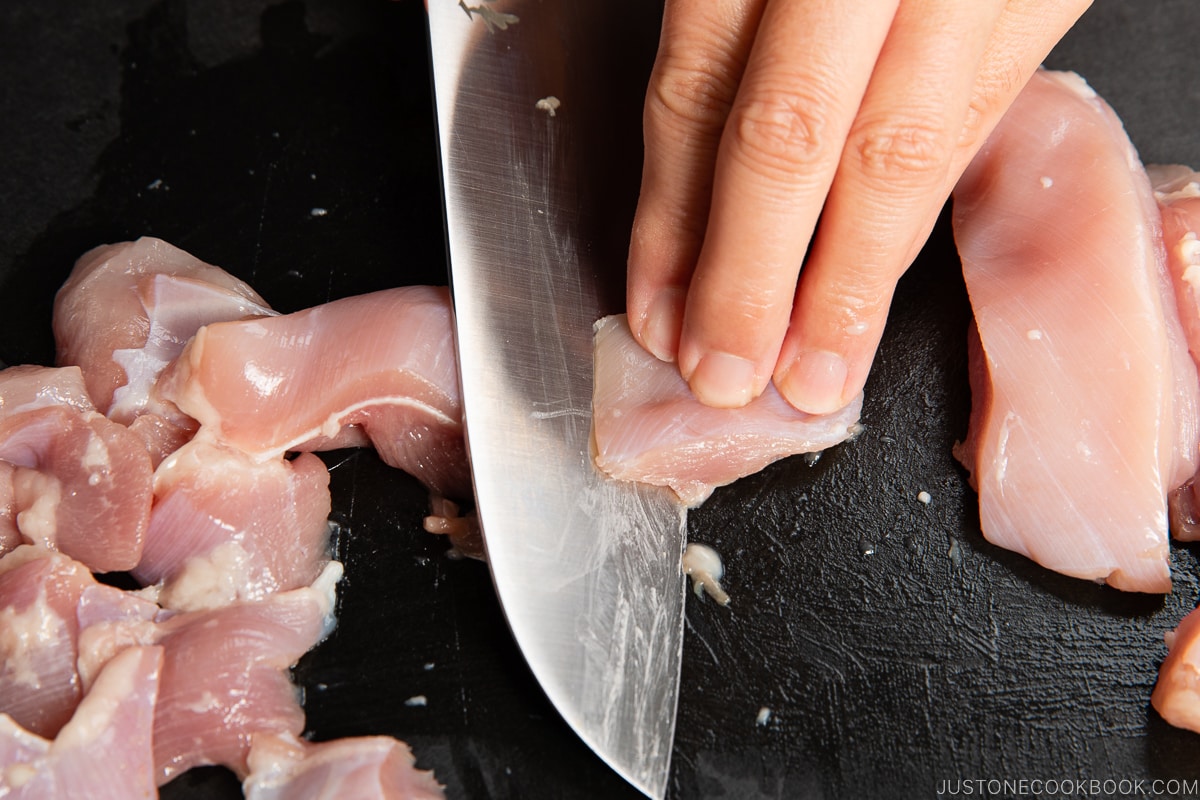
Also, after trying out different sizes of chicken pieces, I realized that cutting the chicken into 2-cm (3/4 inch) pieces worked the best. Big pieces of chicken tend to separate from the rest of the ingredients while smaller pieces are better at incorporating with the onions and soft-cooked eggs.
Tip 2: “Cut” the egg whites
For the best-looking oyakodon, aim for high color contrast between the white and yellow parts of the eggs. That’s why it’s important not to beat the eggs. If you use a beaten egg mixture, you will get one uniform yellow color on your oyakodon.
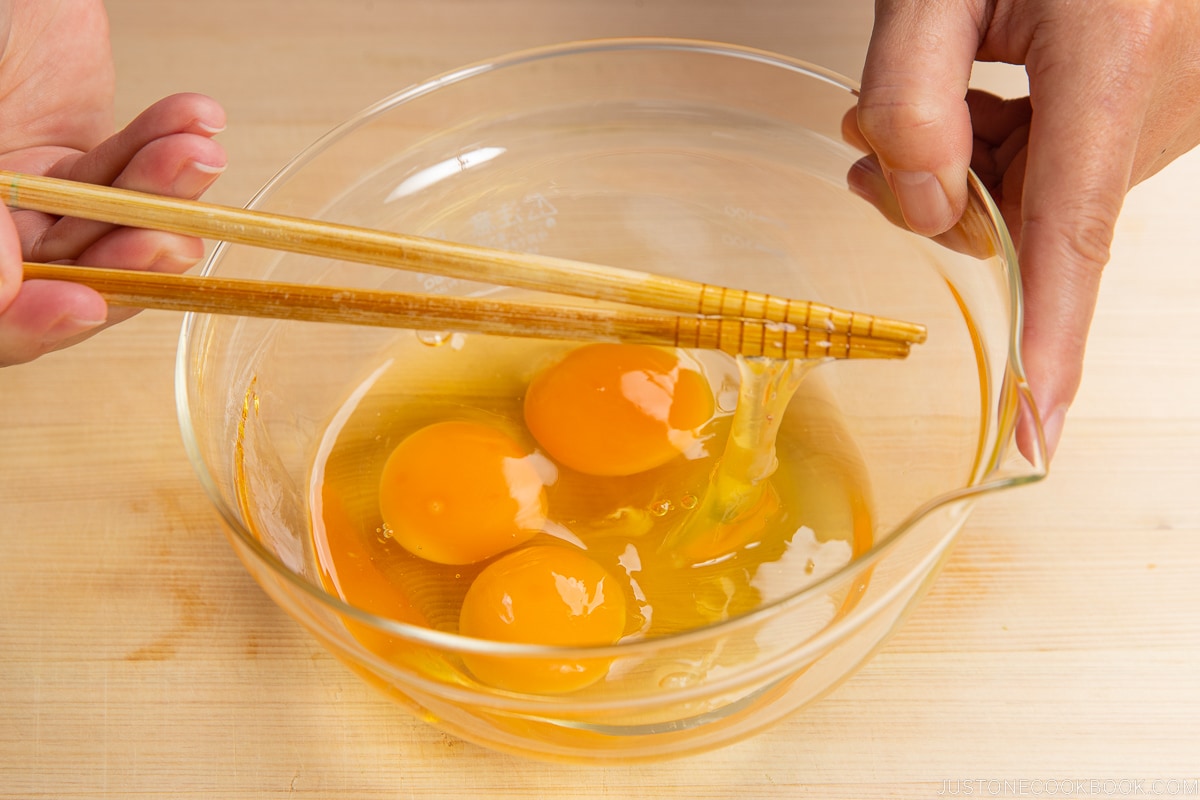
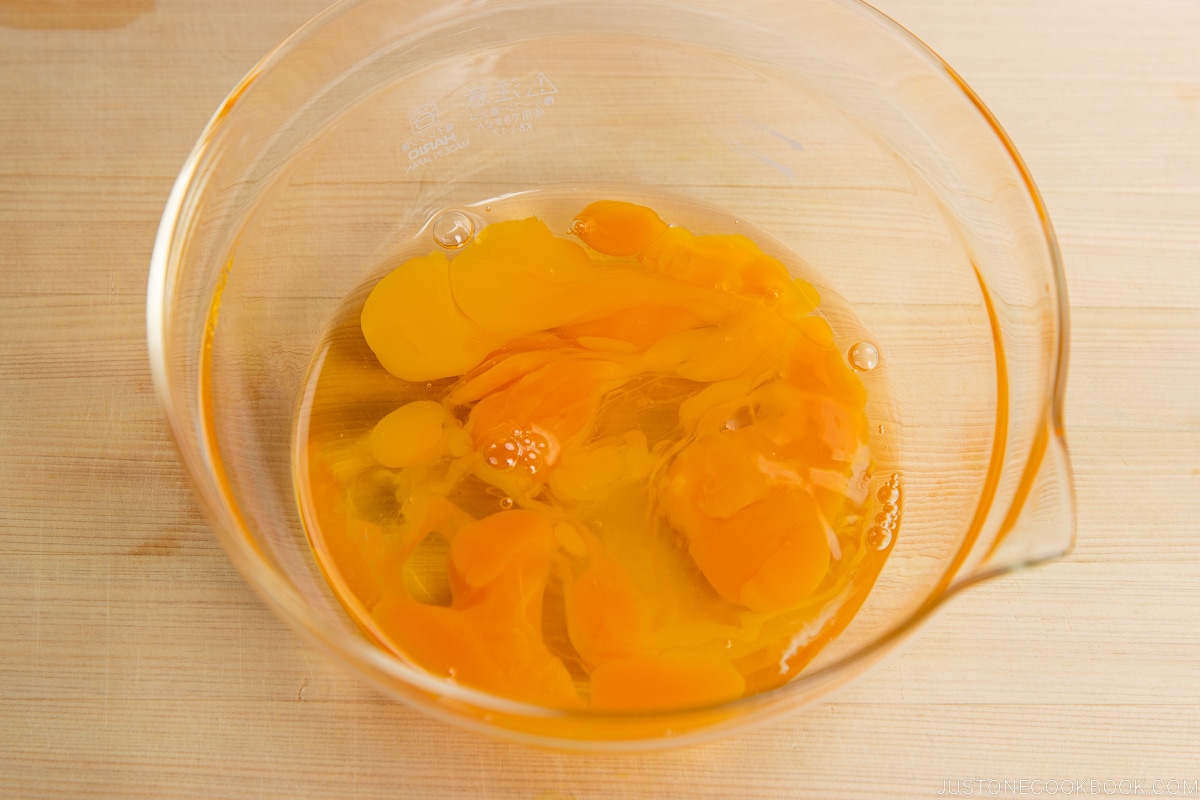
Instead, “cut” the egg whites 5-6 times with a pair of chopsticks, lifting the whites to break them up into a few smaller clumps. This will prevent the egg whites from falling into the frying pan all at once.
How about the egg yolks? While cutting the egg whites, you may have accidentally broken some of the egg yolks. That’s perfect!
You don’t want to blend the yolks and whites together. If the yolks haven’t broken yet, you can gently break them a little bit. The egg whites and yolks are broken, but still distinct, and they should look like a marble pattern.
The standard number of eggs for oyakodon is 2 eggs per serving. The eggs bind all the other ingredients in the simmering sauce together so that the finished oyakodon can slide onto the bed of steamed rice smoothly.
If you’re cooking for two servings in a medium frying pan, you can use 3 eggs, 1½ eggs per serving. However, I don’t recommend using fewer eggs than that as they won’t be able to bind all the ingredients together.
Tip 3: Cook 2 servings at a time
Let’s say you want to multiply the recipe for your family of four or six. The ingredients and seasonings will increase significantly compared to two servings, but I assume your cooking surface will not double or triple in size.
When you try to cook 4 to 6 servings in a medium frying pan (11-inch or 28 cm), the seasonings will not evaporate as efficiently as with 2 servings, and your oyakodon will end up with a lot of sauce, almost like a soup. On top of that, you will overcrowd the pan with ingredients, which will take a long time to cook.
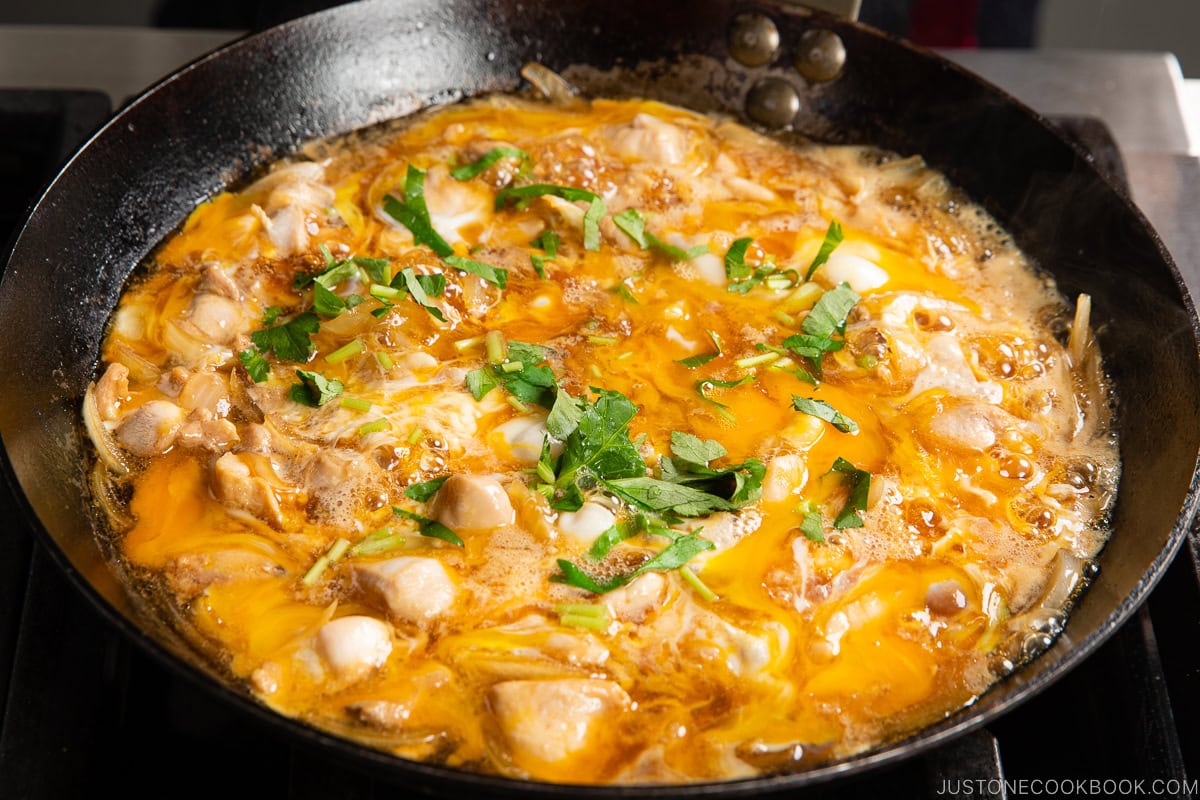
Therefore, I recommend using 2 frying pans, making 2 servings in each frying pan. You could also use a 3.5 QT braiser (16 inches or 40 cm) to make 4 servings of oyakodon at once.
Tip 4: Cook oyakodon uncovered (no lid required!)
I’ve made oyakodon both with and without a lid, testing out the cooking time, flavor, and texture and adjusting the seasoning mixture to achieve the best result.
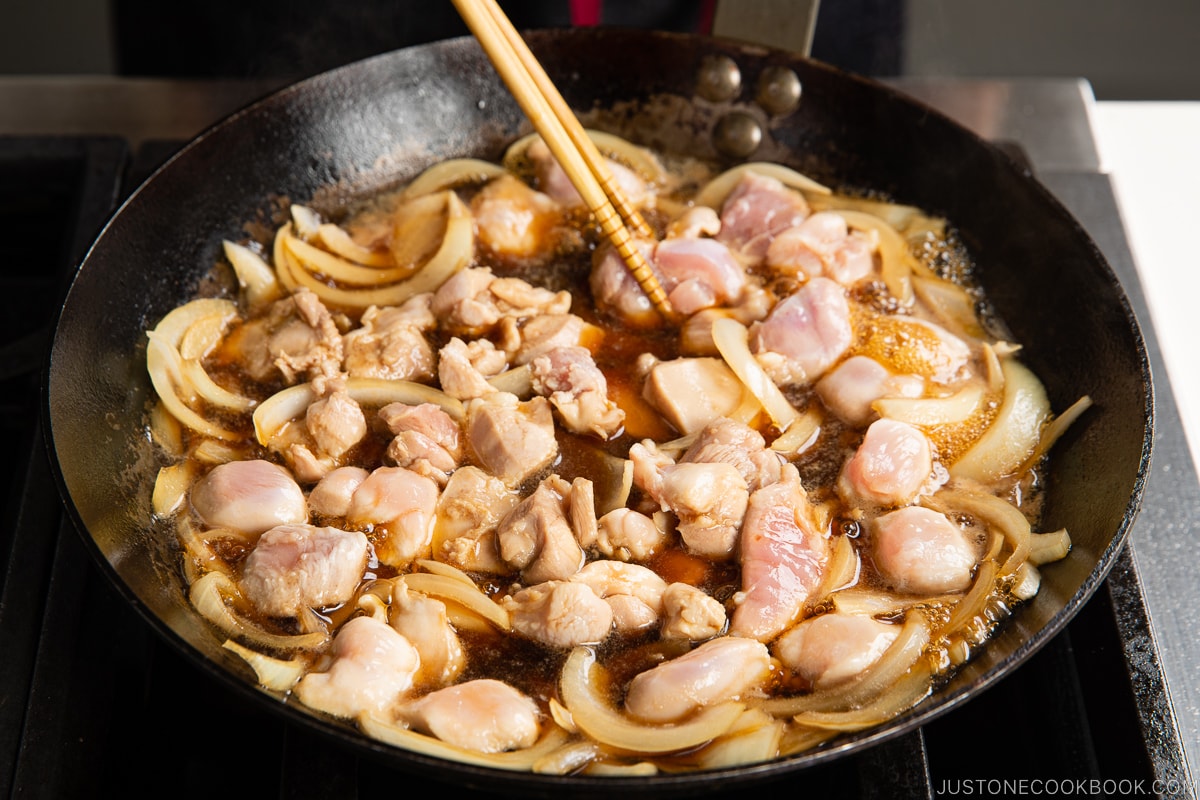
With a lid on, the chicken will cook slightly faster, but the inside of the pan gets quite hot and the chicken can get overcooked while you want to simmer a bit longer for the chicken to absorb more flavors.
After multiple tests, my final verdict is to cook uncovered. When you cook uncovered, the excess moisture from the onion and chicken will evaporate, which yields a more flavorful and intense sauce.
One exception is for cooking the eggs. If you prefer to fully cook the eggs, you may want to use a lid.
Tip 6: Add the eggs at two separate times
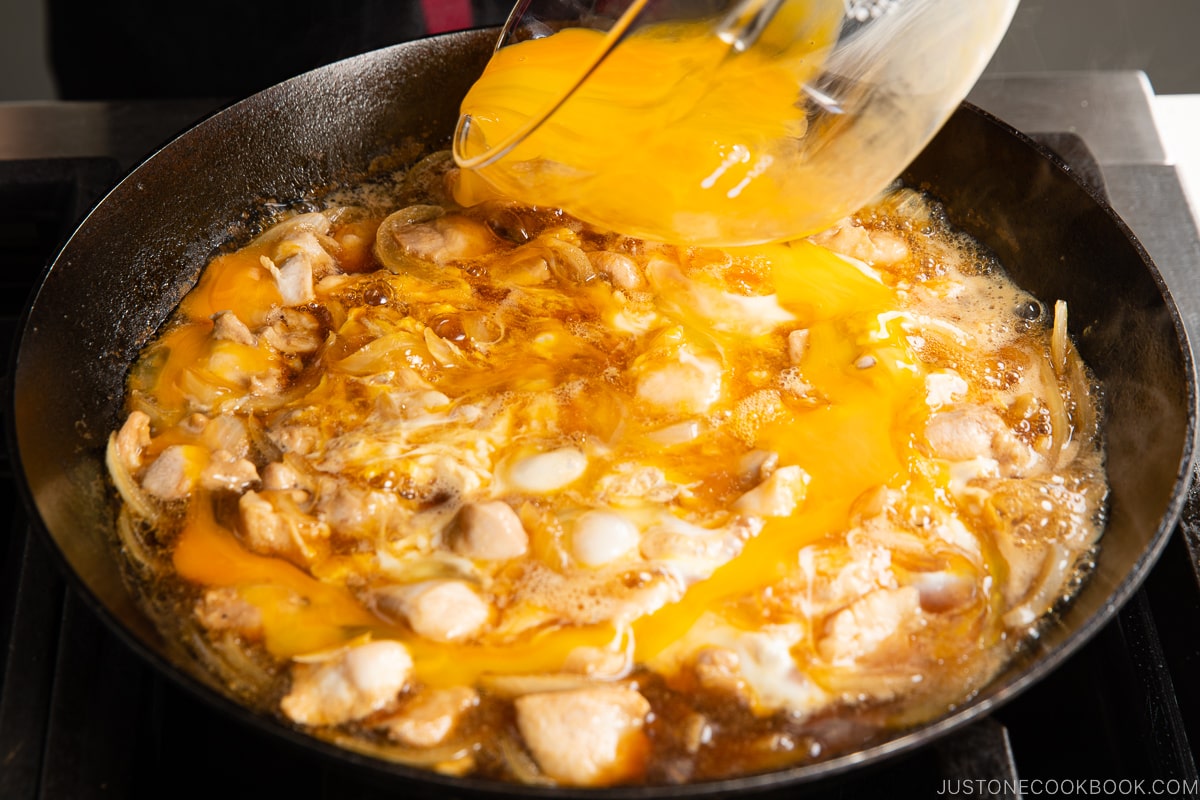
To achieve an ideal egg texture for delicious oyakodon, aim for egg whites that are somewhat firm but still wobbly and egg yolks that remain soft and runny. Since raw eggs are safe to consume in Japan, oyakodon can look a bit different when it’s served in Japan. Don’t be shocked if the eggs are a lot more on the runny and raw side there.
If you live outside of Japan, it’s best to cook the eggs slightly longer than how it’s cooked in Japan. It may not look as pretty, but it’s for food safety reasons.
To achieve the fluffy soft-cooked egg for oyakodon, we add the eggs to the simmering chicken and egg mixture at two separate times:
- Add two-thirds of the eggs (ideally more egg whites because they take longer time to cook than egg yolks) to the center of the pan, avoiding the edges where eggs get overcooked.
- Add the remaining one-third of the eggs (ideally more egg yolks) to the entire surface of the pan.
One last tip! It’s faster to cook egg whites when the eggs are already at room temperature.
Why Cooking in an Oyakodon Pan?
In Japan, oyakodon is typically made in this single-serving oyakodon pan. As you see in the picture below, this special pan helps slide the well-layered dish, including the sauce and soft-cooked egg, into the donburi bowl over a bed of steamed rice.
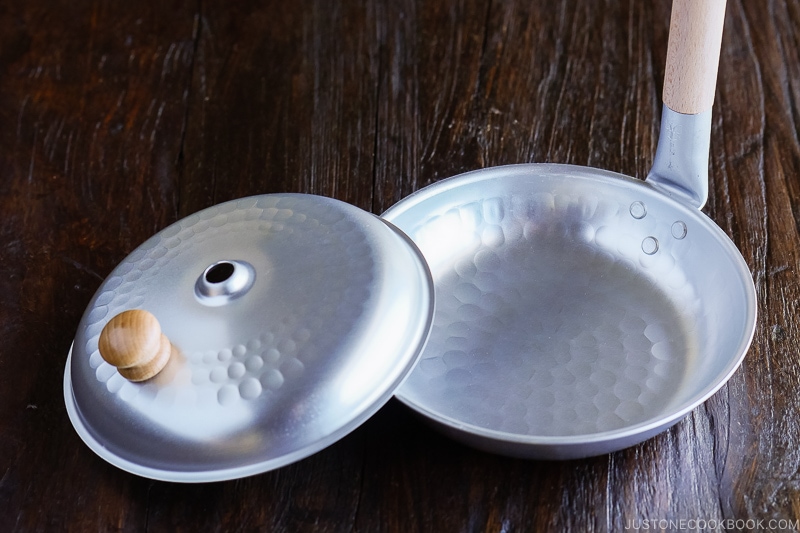
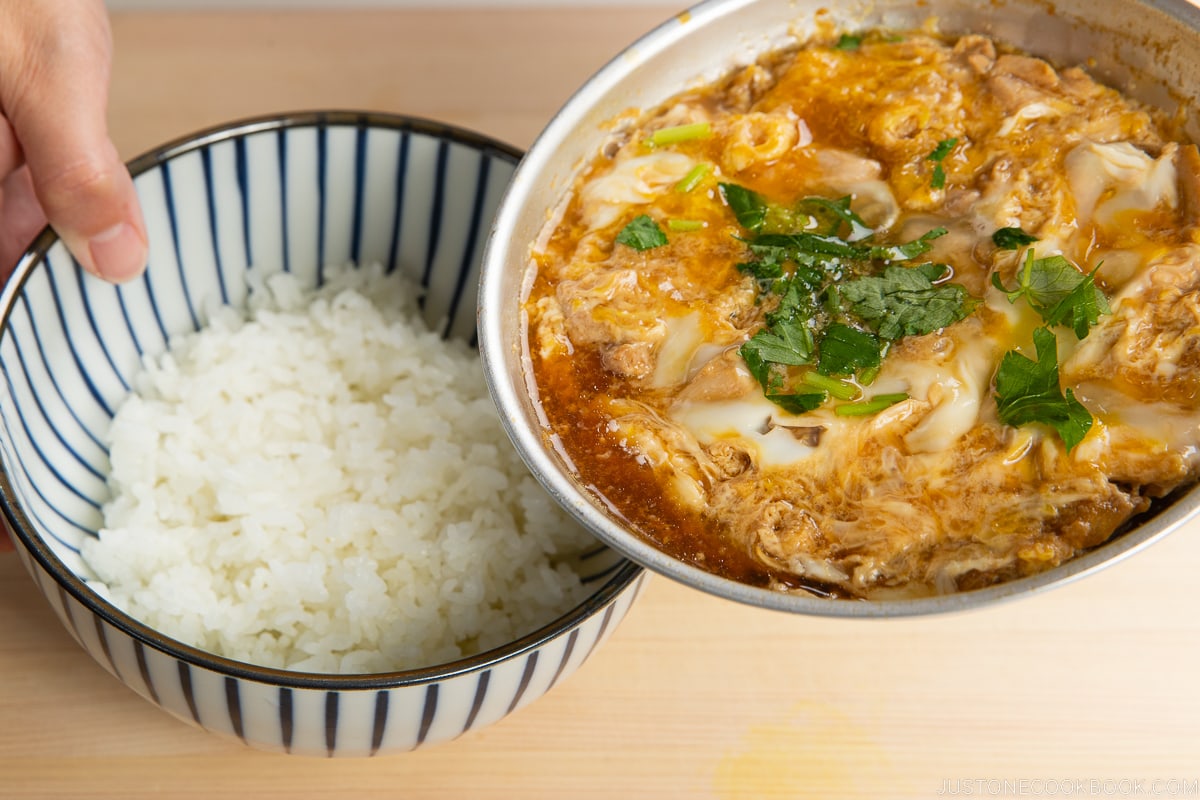
Not only is it easy to serve, but the presentation looks better with a cleaner look. See the picture below.
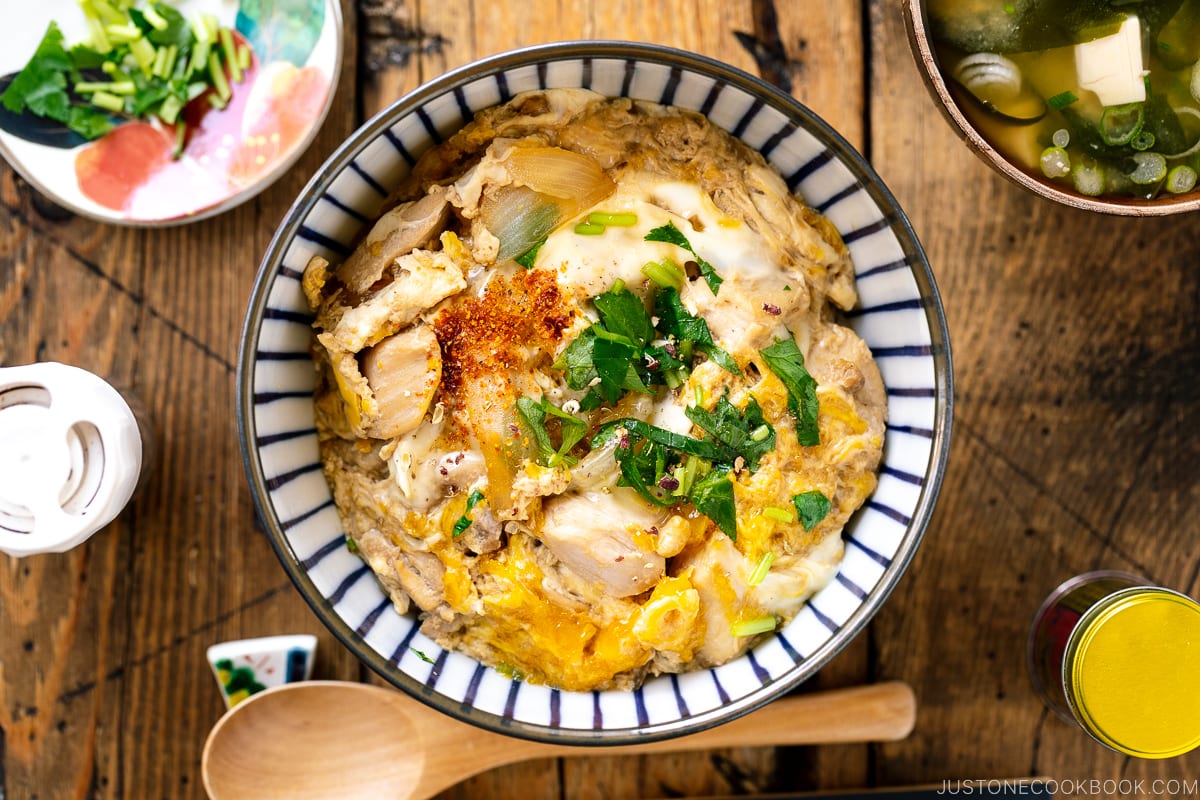
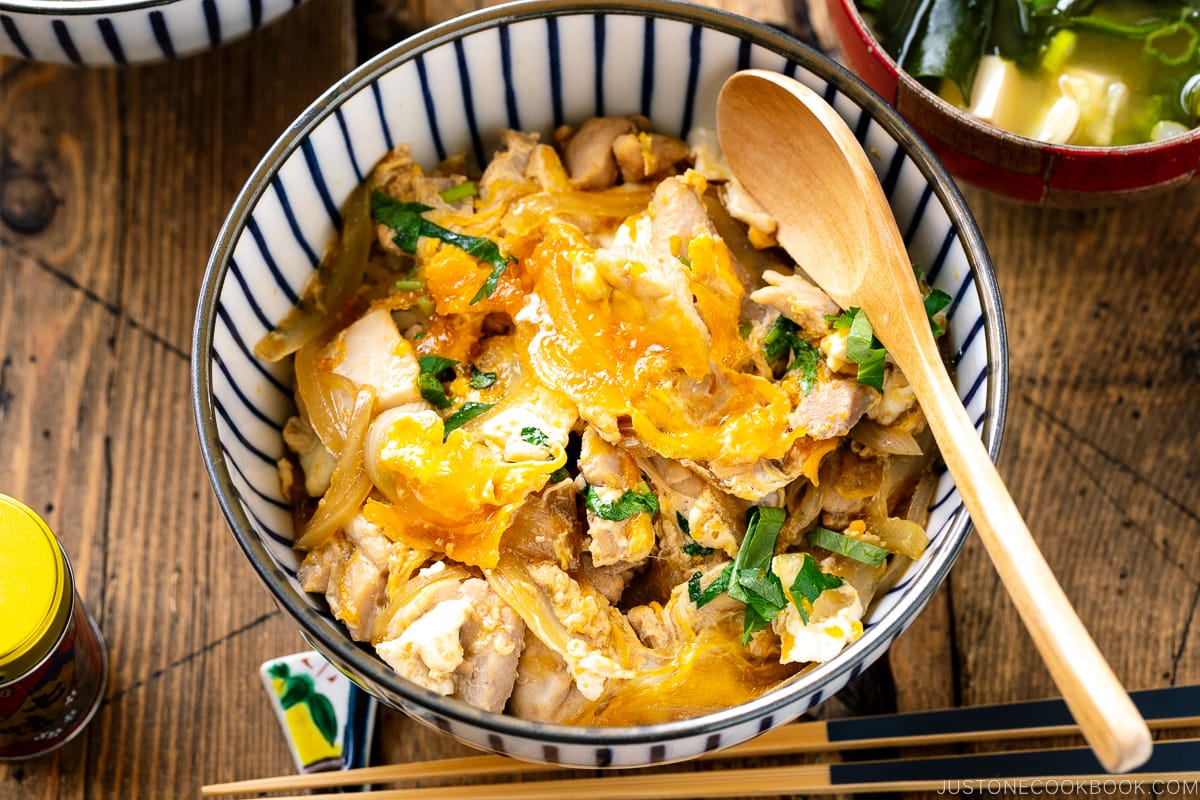
When you cook oyakodon in a medium frying pan, you will end up breaking up the nicely layered dish despite your best attempt. A large flat spoon helps transfer a bigger portion to the bowl, but it will still not be big enough to cover the steamed rice. So restaurants and some home cooks use the single-serving oyakodon pan just to achieve the proper look of the dish.
Besides an oyakodon pan, you can also use a small shallow frying pan that is slope-sided, so you can easily transfer the chicken and egg mixture to the bed of rice in a donburi bowl. Ideally, the diameter of the pan should be the same or smaller size pan as your bowl.
Where to buy an oyakodon pan? You can find one in the following online stores:
What is the Best Rice Cooker?
To make the perfect rice for gyudon, I like to use my Zojirushi NP-NWC10XB Rice Cooker. It makes fluffy rice every time and is the best Japanese rice cooker I’ve ever used! You can get it on Amazon for about $445, and it’s well worth it if you cook a lot of rice.
More Easy Rice Bowl Recipes
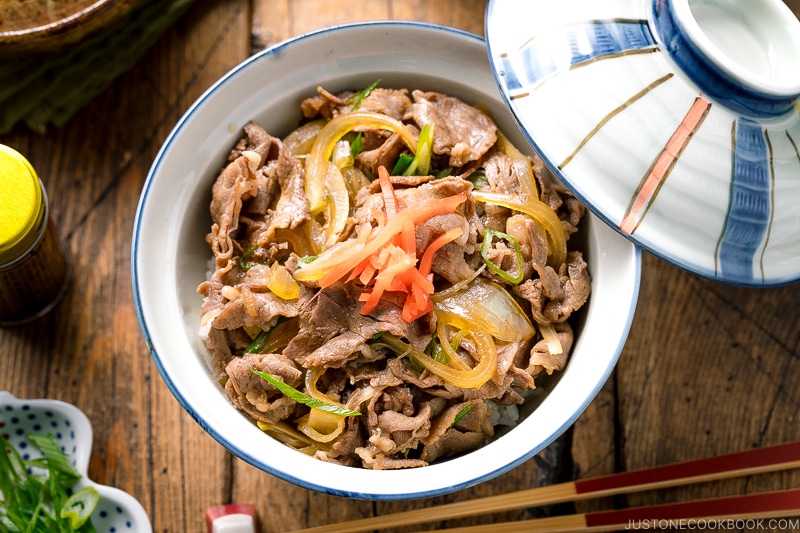
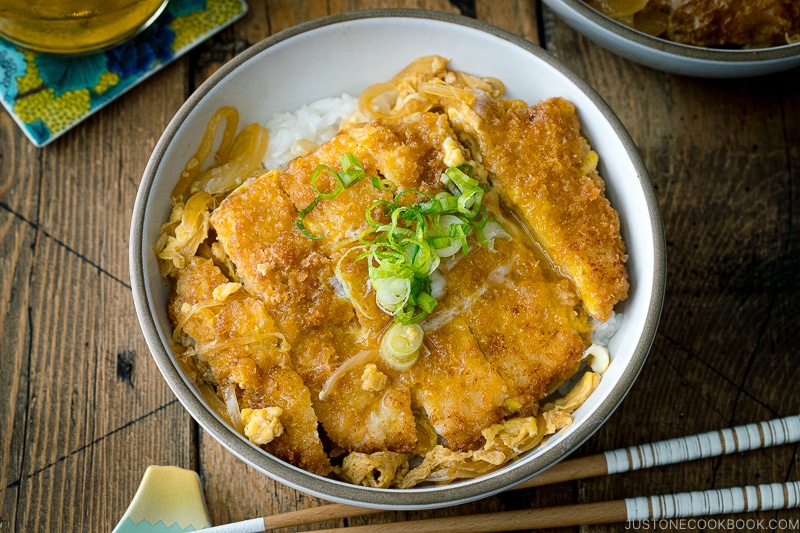
- Gyudon (Quick Beef Bowl)
- Tanin Don (Beef and Egg Rice Bowl)
- Chicken Katsudon
- Pork Curry Bowl
- 12 Donburi Recipes

Oyakodon (Chicken and Egg Rice Bowl)
Equipment
- Instant Pot, you can use either a rice cooker or an Instant Pot to make the rice for this recipe — I've added links to both of my favorites!
Ingredients
- ½ onion (4 oz, 113 g; peeled)
- 10 oz boneless, skinless chicken thighs (typically 1–2 thighs; use plant-based meat substitute for vegan/vegetarian)
- 1 Tbsp sake (for marinating the chicken; substitute with Chinese rice wine or dry sherry, or omit)
- 3-4 large eggs (50 g each w/o shell) (at room temperature; for vegan/vegetarian, use egg substitute such as JUST Egg)
For the Seasonings
- ½ cup dashi (Japanese soup stock) (use standard Awase Dashi, dashi packet or powder, or Vegan Dashi)
- 2 Tbsp soy sauce
- 2 Tbsp mirin
- 2 tsp sugar
For Serving
- 2 servings cooked Japanese short-grain rice (typically 1⅔ cups (250 g) per donburi serving)
- 4 sprigs mitsuba (Japanese parsley) (or green onion/scallion)
- shichimi togarashi (Japanese seven spice) (optional)
- Japanese sansho pepper (optional)
Instructions
Before You Start…
- For the steamed rice, please note that 1½ cups (300 g, 2 rice cooker cups) of uncooked Japanese short-grain rice yield 4⅓ cups (660 g) of cooked rice, enough for 2 donburi servings (3⅓ cups, 500 g). See how to cook short-grain rice with a rice cooker, pot over the stove, Instant Pot, or donabe.
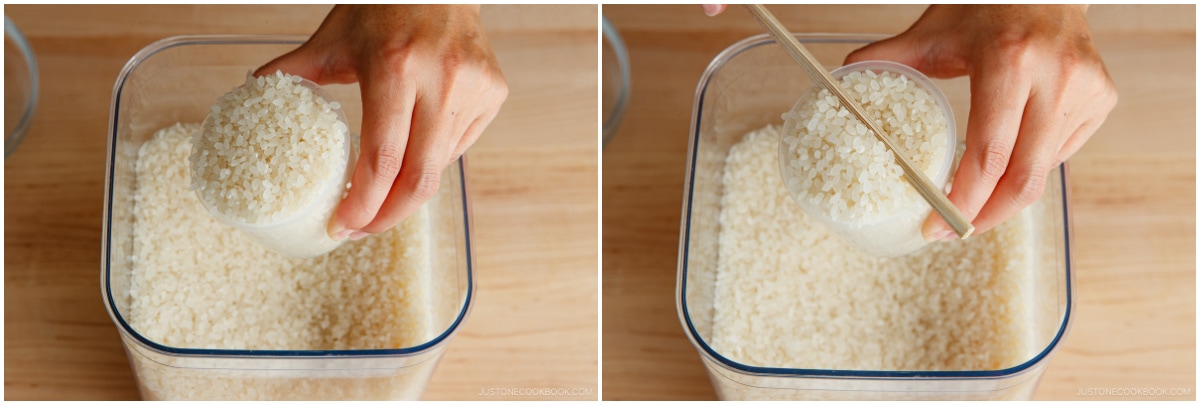
- This recipe includes both cooking methods—using a medium frying pan (about 10 inches/25 cm) and an oyakodon pan or small frying pan (8 inches/20 cm). Typically, oyakodon is made individually for each serving using an oyakodon pan, which lets you slide the cooked ingredients onto the rice bowl easily. See the separate cooking instructions below.

- Gather all the ingredients. Do not make more than two servings in a medium frying pan. I explained a bit more in the blog post (under Oyakodon Cooking Tips). If you are making four servings, use two medium frying pans.
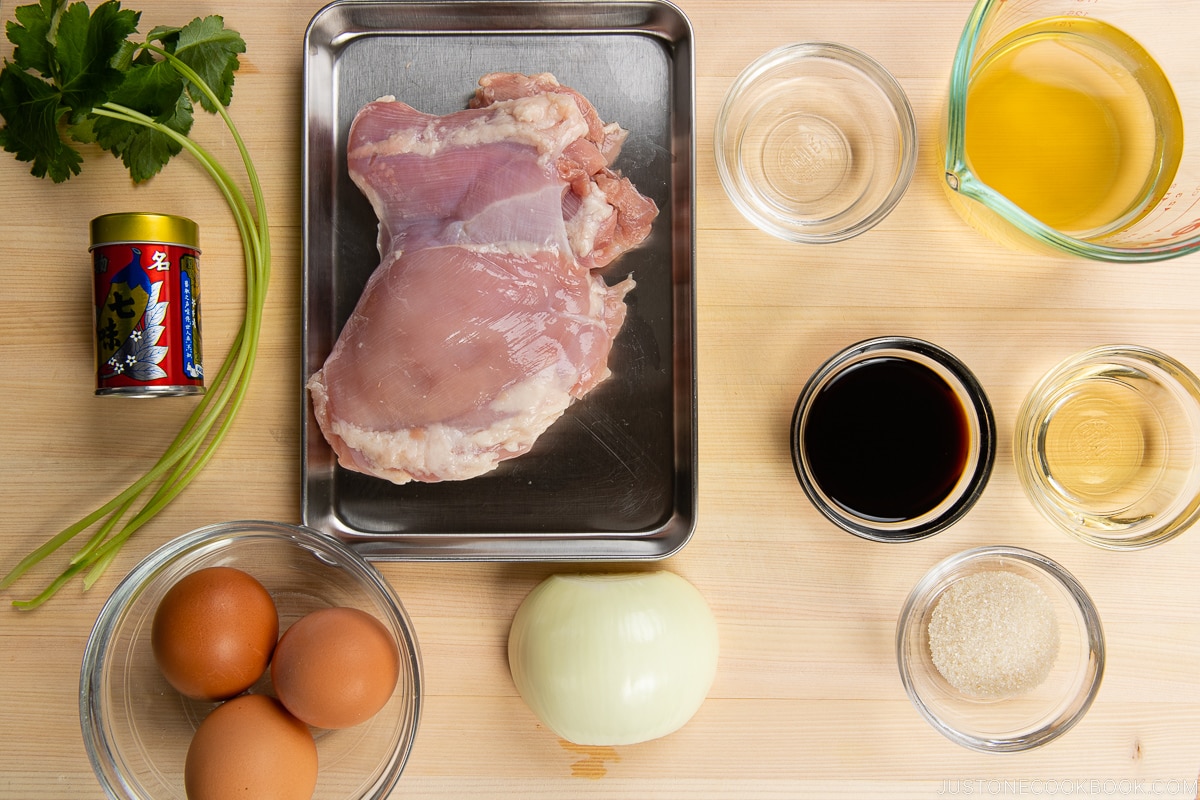
To Prepare the Seasonings
- Combine ½ cup dashi (Japanese soup stock), 2 Tbsp soy sauce, 2 Tbsp mirin, and 2 tsp sugar in a bowl or a liquid measuring cup and mix all together until the sugar is dissolved.
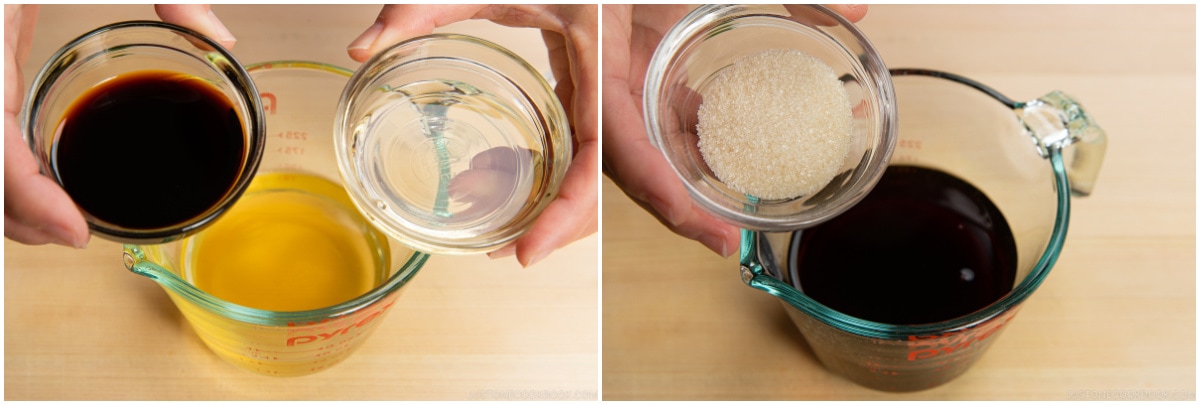
To Prepare the Ingredients
- Slice ½ onion lengthwise, about ¼ inch (6 mm) wide.
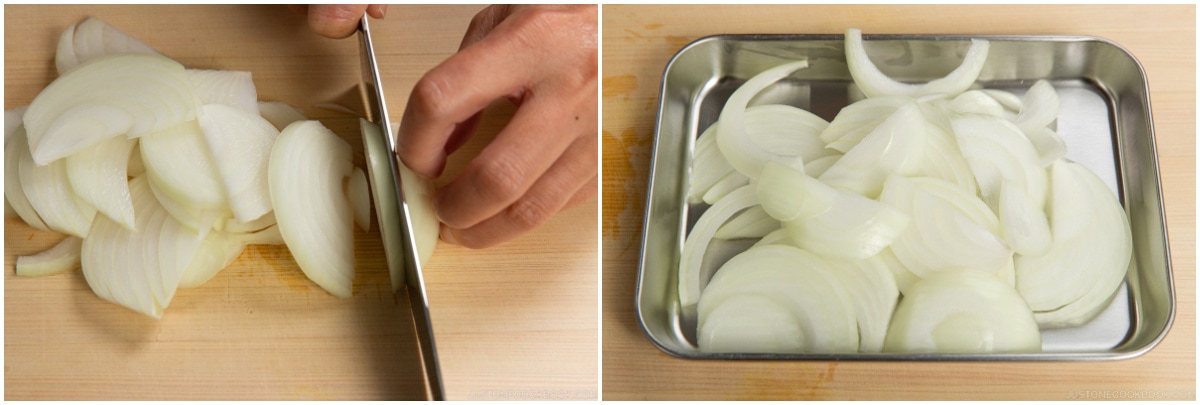
- Chop 4 sprigs mitsuba (Japanese parsley) ½ inch (1.3 cm) wide.
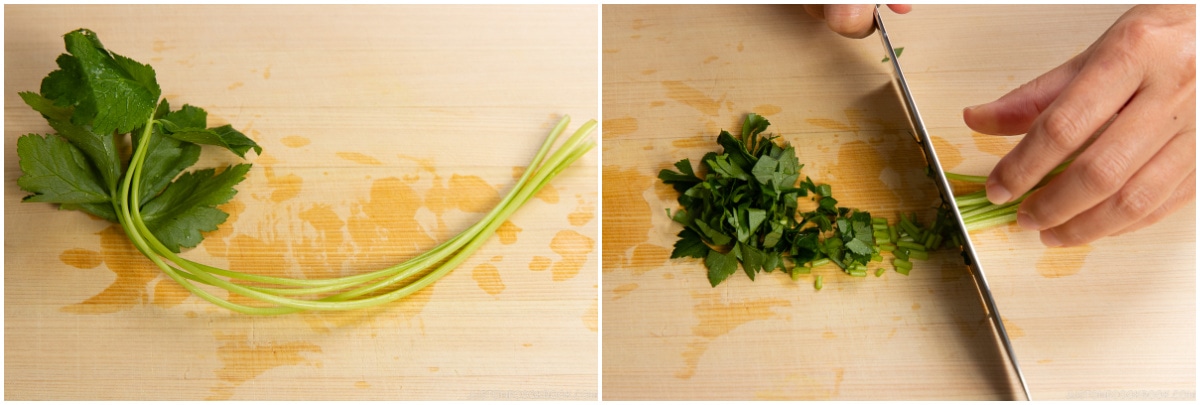
- Trim the extra bits of fat and connective tissue from 10 oz boneless, skinless chicken thighs with the knife.
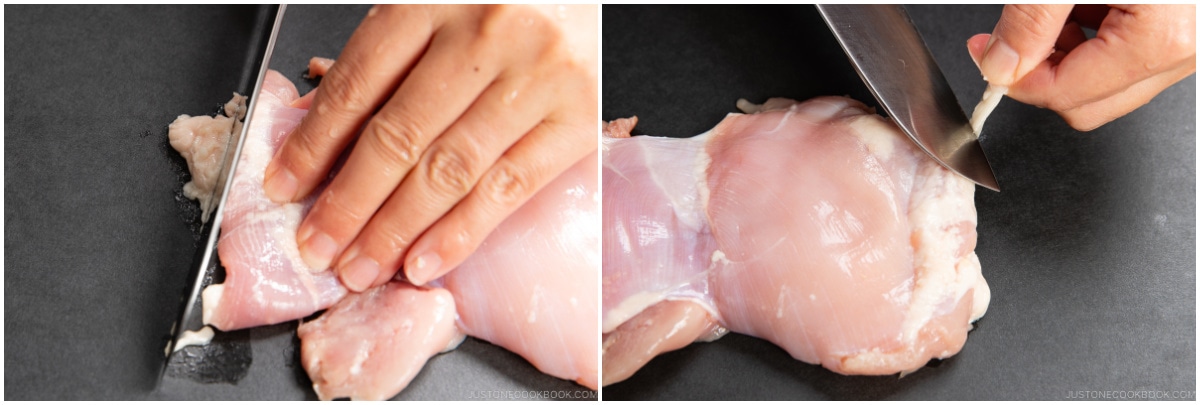
- Cut the chicken thigh along the grain into strips ¾–1 inch (2–2.5 cm) wide. Next, angle your knife back and diagonally (nearly parallel to the cutting board), and then slice the chicken strips against the grain into pieces about ¾–1 inch (2–2.5 cm) square. This sogigiri cutting technique gives the chicken pieces equal thickness and creates more surface area for fast cooking and better absorption of the flavors.
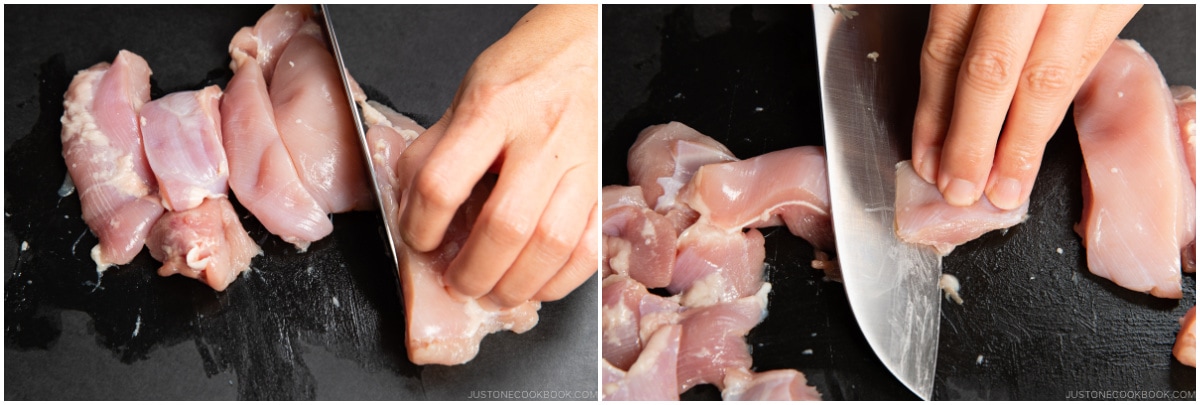
- Transfer the chicken to a bowl or tray and sprinkle with 1 Tbsp sake. Set aside for 5 minutes.
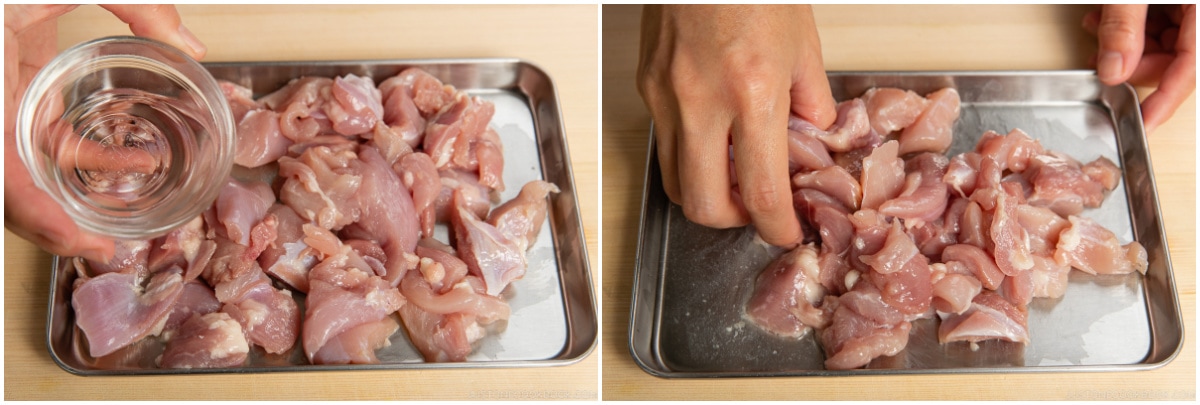
- Crack 3-4 large eggs (50 g each w/o shell) into a bowl. Using a pair of chopsticks, lift the egg whites to “cut“ them 5–6 times into a few smaller clumps. This will prevent the egg whites from falling into the frying pan all at once. Do not whisk or beat the eggs together. Tip: Aim for high color contrast between the white and yellow parts of the eggs in your finished dish.
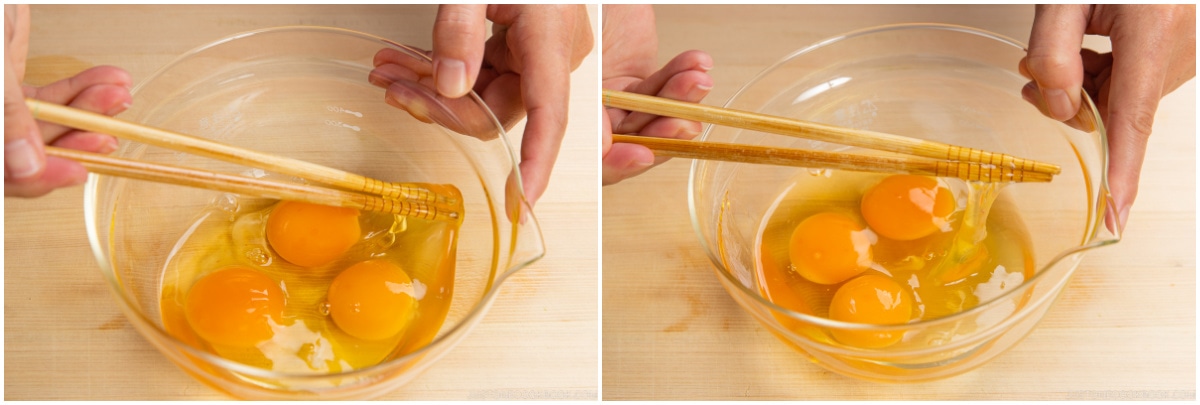
- While “cutting“ the egg whites, you may have accidentally broken some of the egg yolks. That‘s okay. If the yolks haven‘t broken yet, you can poke them to gently break them, but do not blend the egg whites and yolks. The eggs should resemble a marble pattern.
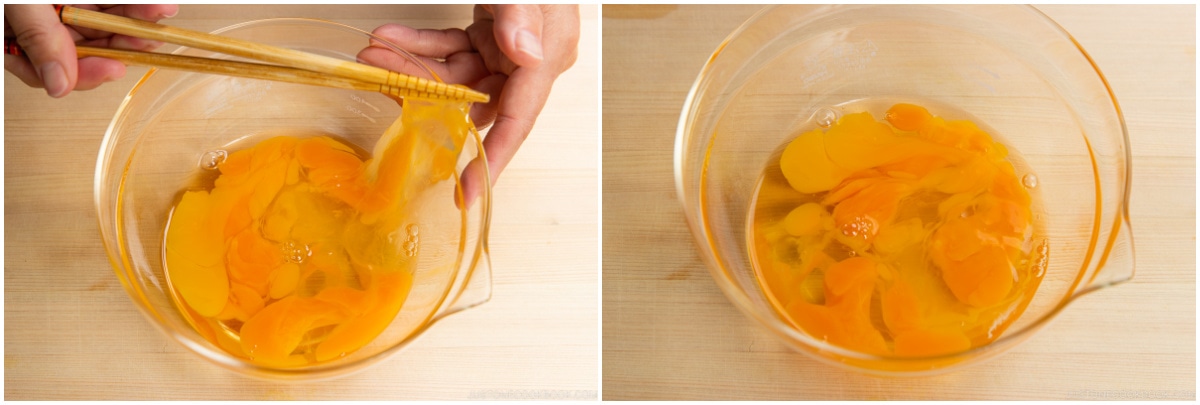
To Cook the Oyakodon in a Medium Frying Pan
- With the stove off, add the sliced onions to a medium frying pan (I use a well-seasoned 11” carbon steel pan) in a single layer. Then, add the seasonings mixture. It should just cover the onions. If not, your frying pan is too big and you need to either increase the seasoning or use a smaller pan.
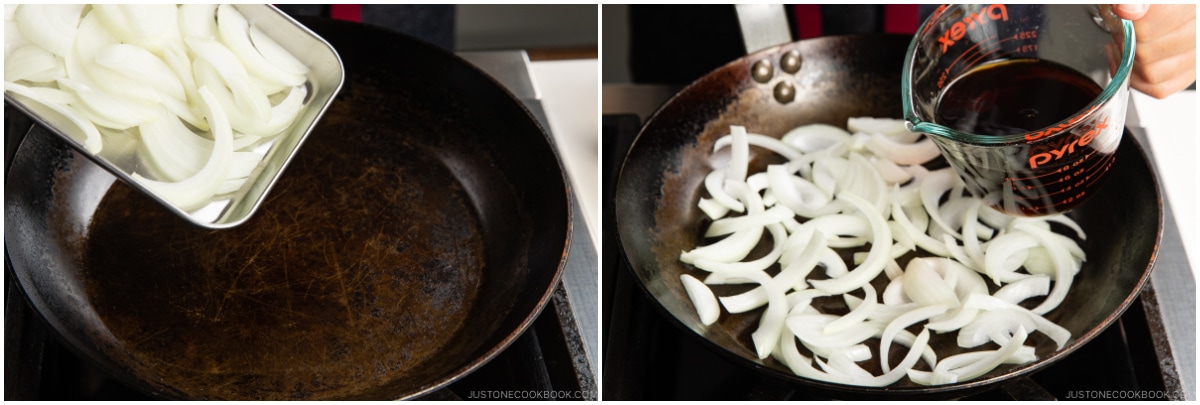
- Turn on the heat to medium and bring it to a simmer. Once simmering, add the chicken on top of the onions.
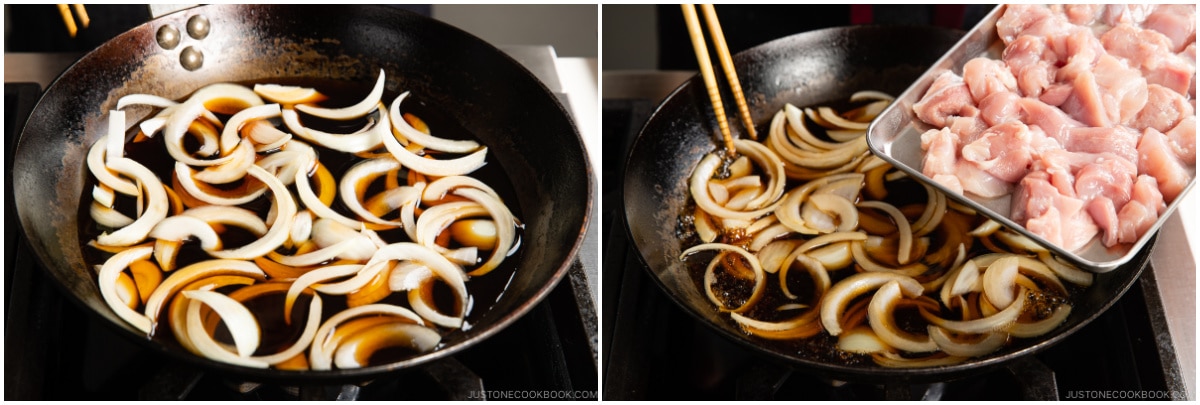
- Make sure the onions and chicken are evenly distributed. Once simmering again, lower the heat to medium low. Cook, uncovered, for 5 minutes or until the chicken is no longer pink and the onions are tender. Halfway through, flip the chicken. Tip: Evaporation reduces the sauce and intensifies the flavor.
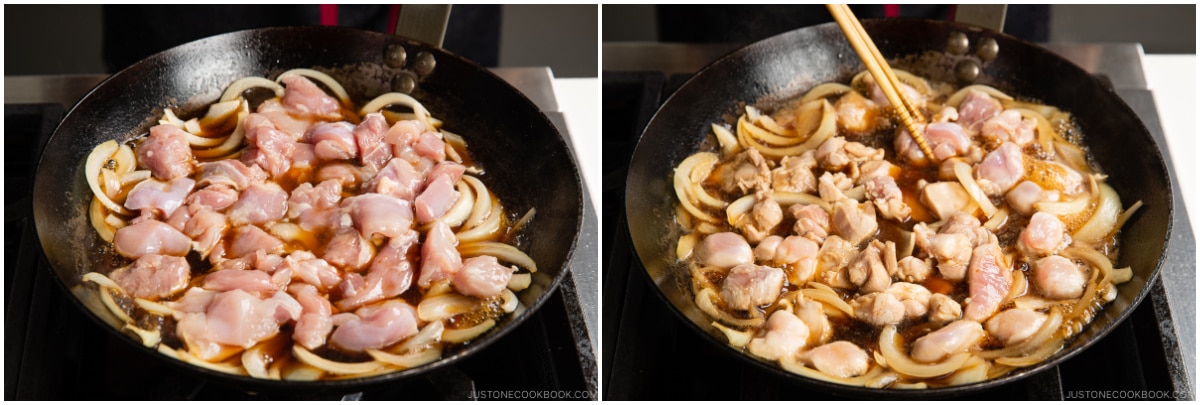
- We will add the eggs in two stages: Two-thirds of the eggs first, then the remaining one-third later. Now, increase the heat to medium. With the cooking liquid simmering (small bubbles around the edges), drizzle two-thirds of the eggs in a circular pattern over the chicken and onions, avoiding the edges of the pan where the eggs can easily overcook. Tip: Only drizzle the eggs if the cooking liquid is simmering, as with Egg Drop Soup. Also, try to add more egg whites at this stage, as the whites take longer to cook than the yolks. Ideally, we want to keep the yolks soft and runny for the final presentation.
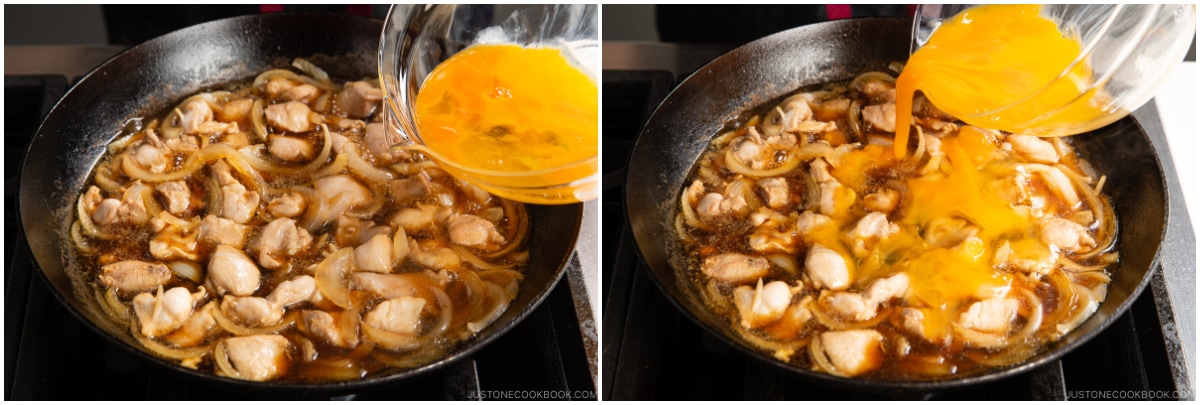
- If the heat is too strong, lower the heat. If the egg is moving toward the edges of the pan, gently gather it toward the center where the heat is not as strong. Optionally, you can cover the pan if the egg whites are taking a long time to set.
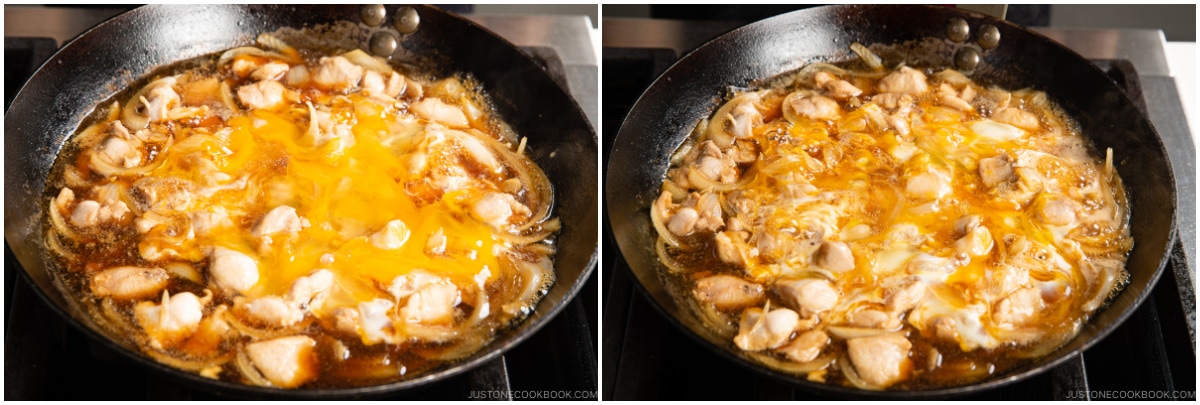
- When the eggs are still runny but just set, add the rest of the eggs to the center and around the edges of the pan. Add the mitsuba (or green onion) on top and cook on medium low until the egg is done to your liking. Usually, oyakodon in Japan is served while the egg is almost set but still runny (raw eggs are safe to consume in Japan). Tip: For the remaining one-third of the egg, try to distribute more egg yolks so the oyakodon will have a bright yellow color on top. For a good presentation, you can add a beaten extra yolk at the end.
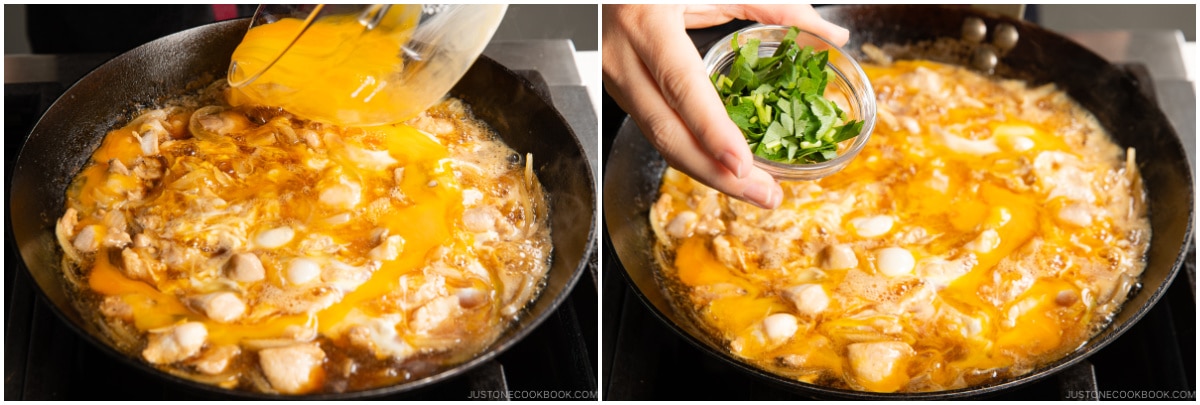
- Serve steamed rice in individual serving bowls. Spoon the cooked chicken and egg mixture onto the steamed rice and drizzle the desired amount of pan sauce on top.
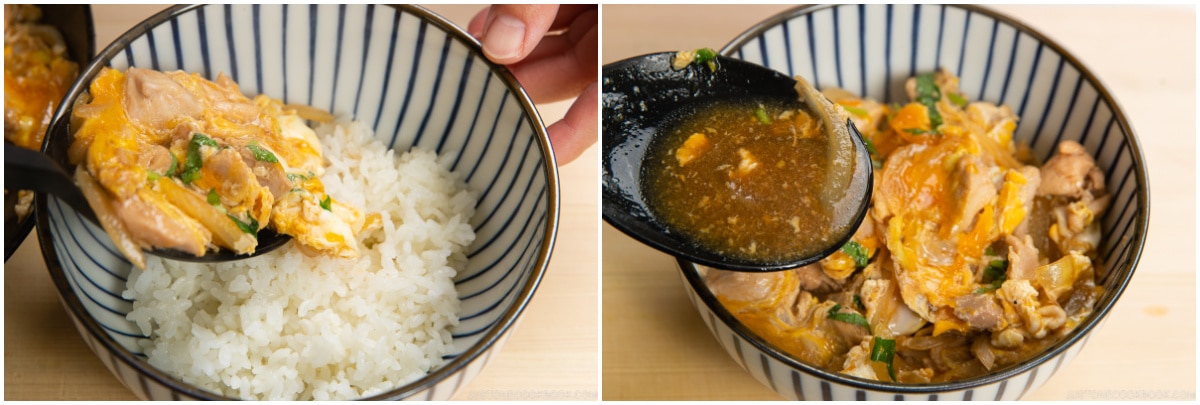
To Cook the Oyakodon in an Oyakodon Pan or a Small Frying Pan
- Cook the chicken and egg in two batches, one serving at a time. Make sure to divide the ingredients in half. With the stove off, add half of the sliced onions to the pan in a single layer. Add half of the seasonings mixture (it should just cover the onions).
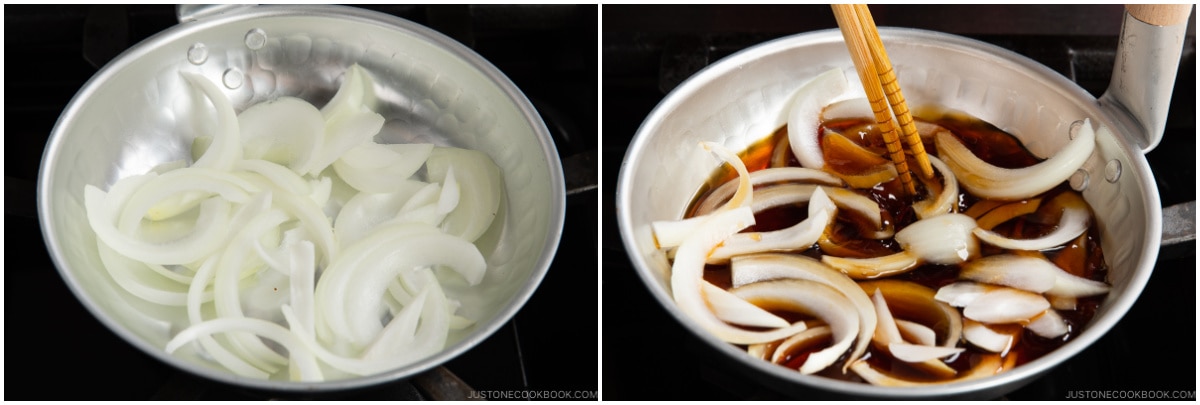
- Turn on the heat to medium and bring it to a simmer. Once simmering, add half of the chicken on top of the onions.
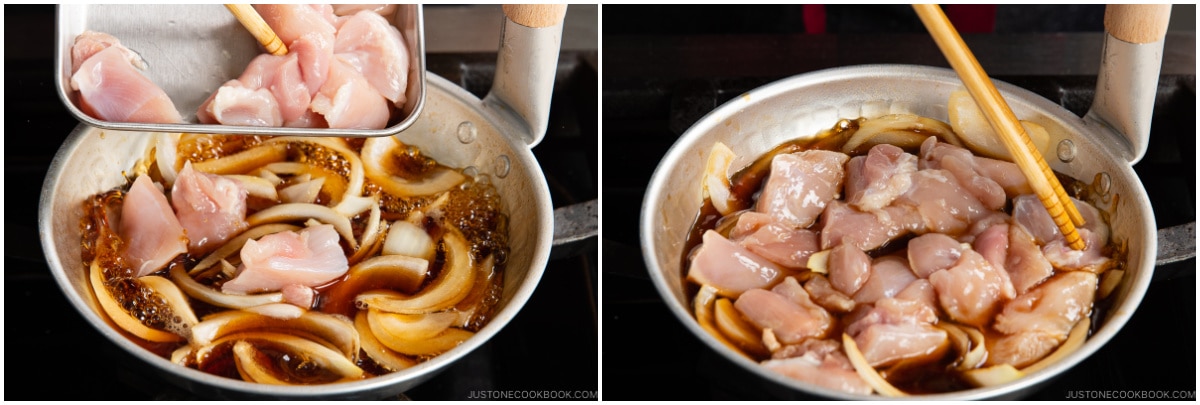
- Make sure the onions and chicken are evenly distributed. Once simmering, lower the heat to medium low. Cook, uncovered, for 4 minutes or until the chicken is no longer pink and the onions are tender. Halfway through, flip the chicken. Tip: Evaporation helps to reduce the sauce and intensify the flavor.
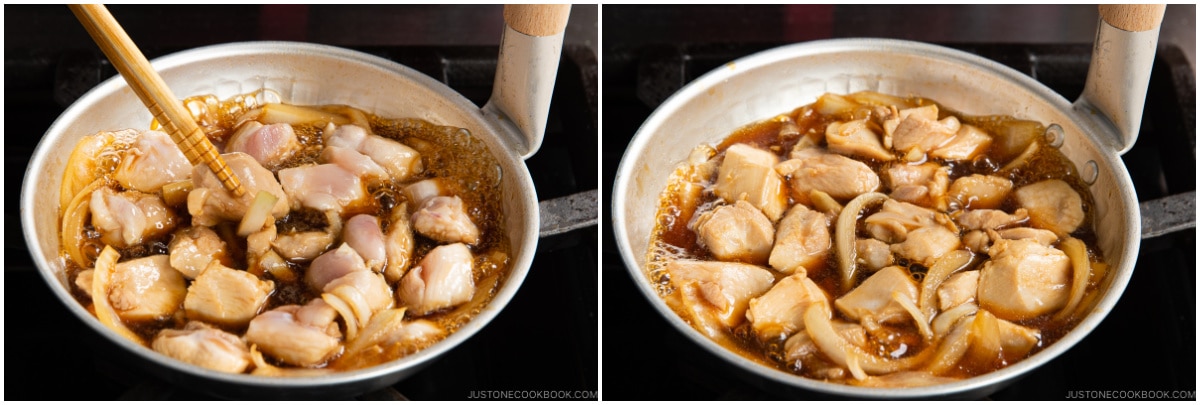
- We will add the eggs in two stages: Two-thirds of the eggs first, then the remaining one-third later. Now, increase the heat to medium. With the cooking liquid simmering (small bubbles around the edges), drizzle two-thirds of the eggs in a circular pattern over the chicken and onions, avoiding the edges of the pan where the eggs can easily overcook. Tip: Only add the eggs if the cooking liquid is simmering, as with Egg Drop Soup. Also, try to add more egg whites at this stage, as the whites take longer to cook than the yolks. Ideally, we want to keep the yolks soft and runny for the final presentation.
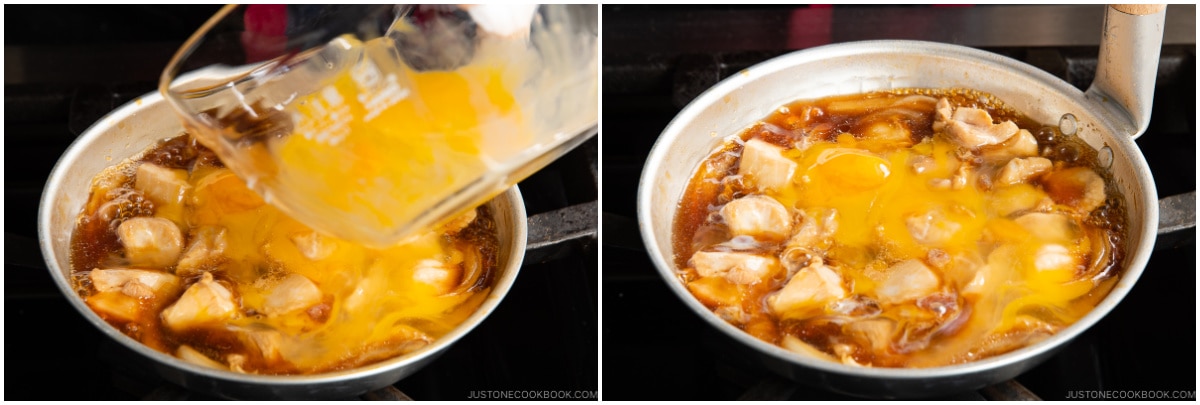
- When the eggs are still runny but just set, add the rest of the eggs to the center and around the edges of the pan. Add the mitsuba (or green onion) on top and cook on medium low until the egg is done to your liking. Usually, oyakodon in Japan is served while the egg is almost set but still runny (raw eggs are safe to consume in Japan). Tip: For the remaining one-third of the egg, try to distribute the egg yolk so the oyakodon will have a bright yellow color on top. For a good presentation, you can add a beaten extra yolk at the end.
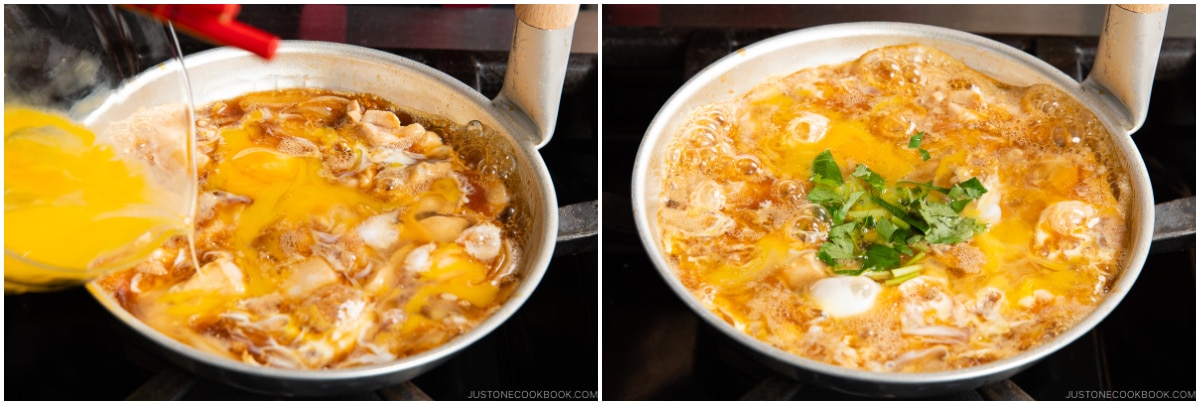
- Portion 2 servings cooked Japanese short-grain rice into individual donburi or other serving bowls. Slide the cooked chicken and egg mixture onto the steamed rice and drizzle the desired amount of pan sauce on top. Repeat Steps 1 to 6 with the remaining ingredients.
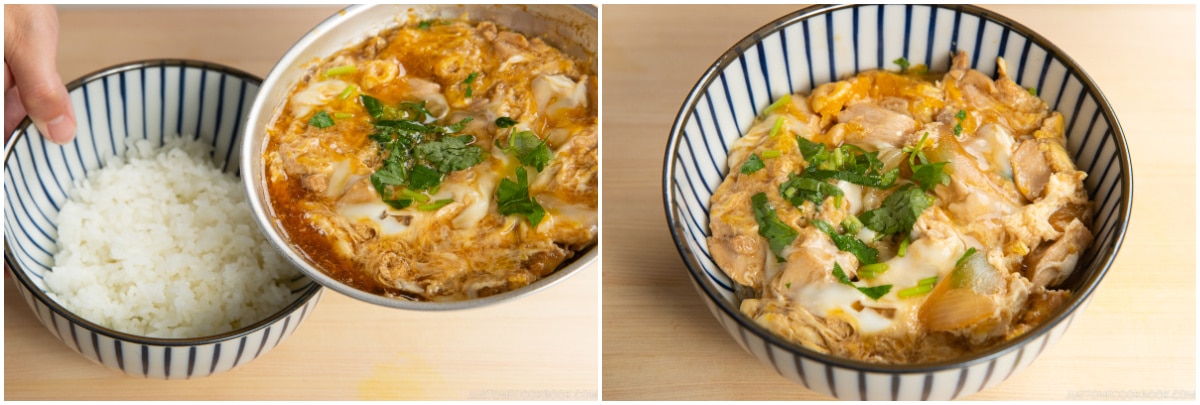
To Serve
- Serve the Oyakodon with optional shichimi togarashi (Japanese seven spice) for a spicy kick and Japanese sansho pepper for a peppery fragrance on the side.

To Store
- You can keep the leftovers in an airtight container and store in the refrigerator for up to 2–3 days.
Nutrition
Did you make this recipe?
Tag @justonecookbook on Instagram so we can see your delicious creation!
Editor’s Note: The post was originally published on February 4, 2011. It has been republished with new images, updated content, and a revised recipe on October 30, 2022. A new video was added to the post on November 22, 2024.


